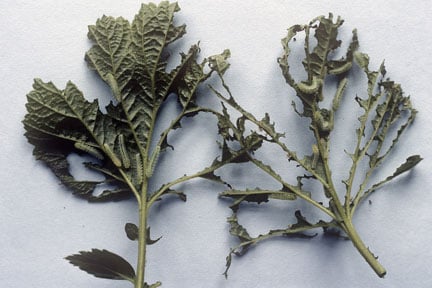
Quick facts
Common name - Geum sawflies
Scientific names - Claremontia waldheimii and Monophadnoides rubi
Plants affected - Geum species
Main symptoms - The foliage is eaten by pale green caterpillar-like larvae
Caused by - Larvae of sawflies
Timing - May-July
What are Geum sawflies?
Sawflies are a group of insects suborder (Symphyta) of the Hymenoptera (bees, ants and wasps). There are about 500 species of in Britain. They have caterpillar-like larvae that feed on plant material and are named after the saw-like egg laying organ used by females to lay eggs in plant material. Adults can come in a range of colours many are black, green orange or striped yellow and black. Most are small (< 1 cm) but some species such as the Birch sawfly (Cimbex femoratus) can be over 2 cm long. Several species can be found in gardens and are part of the a healthy garden will support. More information can be found at The Sawflies of Britain and Ireland webpages
There are two species of geum sawflies they have pale green larva, with small white spines. The larvae reach 15 mm in length that eat the leaves of Geum plants in the spring and summer. The adult insects are about 6 mm long and mainly black.
Symptoms
Geum larvae initially feed concealed between the folds of unexpanded leaves. As they grow they consume large irregular holes and damage can occur very quickly and defoliation can be extensive. Signs of geum sawflies include:
- Pale green caterpillar-like larvae with small whitish spikes up to 15 mm long
- Leaves can be reduced to a network of the larger leaf veins, affecting the appearance and vigour of plants
- Affected plants often recover with no long term effects
Management
Sawflies are a part of the a healthy garden supports.
- Where possible tolerate populations of geum ; Geum can cope with low numbers of larvae, plants usually recover from defoliation
- Encourage predators and other natural enemies of sawfly in the garden, such as birds, wasps and ground beetles
- Check plants regularly in May and June for the presence of larvae to prevent a damaging population developing
- Remove by hand if required and where practical
Biology
The larvae of geum sawflies (Claremontia waldheimii and Monophadnoides rubi) feed on the foliage of cultivated and wild Geum species.
There is one generation a year with larvae active during late May and June. They initially feed concealed between the folds of unexpanded leaves. The larvae of both species are pale green with rows of bifurcated (divided into two) whitish spines on the dorsal surface. When fully grown, in late June, they go into the soil where they spin silk cocoons, where they overwinter. The adults are 5-6 mm in length, black in colour and emerge between late April and early June.














